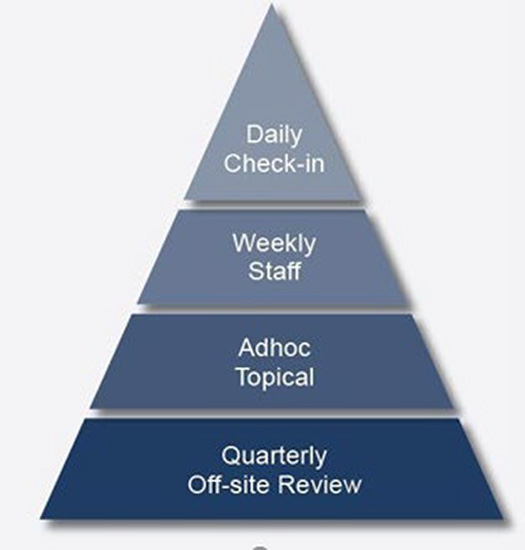Meetings

When 3 or more people gather together, we call this a meeting. Most people dread meetings. Granted many meetings are unnecessary. Meetings are often just hour-long displays of power and politics that eat into the time leaders have to get “real” work done. But since people communicate in groups to get things done, most organizations could not function without meetings. In groups, new ideas emerge that simply can’t when situations are explored alone. It is estimated that organizations spend 7 – 15% of personnel expenses directly on meetings, not including the time spent planning these meetings. Therefore, it is important to get meetings right.
Ideally, teams should have a minimum of 4 distinct meetings on a regular basis:
1. Check-in
Time: 5 – 10 minutes
Frequency: daily
Focus: schedule
Purpose: Keep team members aligned; forum for activity and schedule updates
2. Staff Meeting
Time: 30 -90 minutes
Frequency: Weekly
Focus: Near-term objectives
Purpose: Discus and resolve issues
3. Strategic
Time: 2-4 hours
Frequency: Monthly
Focus: Long-term strategic objectives
Purpose: Discuss and resolve 1-2 issues
Off-site Review
Time: 1-2 days
Frequency: Quarterly
Focus: Strategic management systems
Purpose: Strategic assessment of organizational systems
Separating into four types of meetings will not make team meetings more productive alone. Each meeting must be a productive use of time. Meeting best practices are critical for this.
Workshop
Description: half-day experiential workshop that describes the model, and how to effectively use it and meeting best practices with a team. Leaders leave with action plans to improve their own behavior and how to engage their leadership team.
Length: two hours
Materials: handouts, a self-assessment, Patrick Lencioni’s Five Dysfunctions of a Team book (a $20 value), and SOS Meeting white paper
